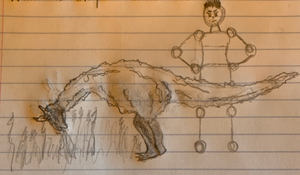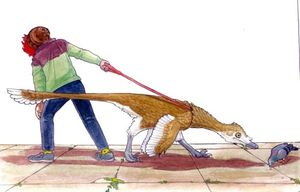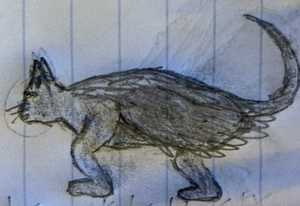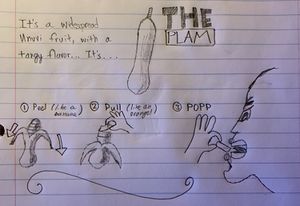Animals: Difference between revisions
Unuvun Rain (talk | contribs) |
Unuvun Rain (talk | contribs) |
||
| Line 3: | Line 3: | ||
=Animals= | =Animals= | ||
== | ==Overview and cladogram== | ||
'''Seraltans''', six-legged egg-laying animals, are the dominant native fauna of Ivinis. In Pangaea, '''paraves''' dominate most niches with the remaining being filled by '''mammals'''. The dominant native fauna of [[Ihyai]] are '''ziflo''', six-legged placental animals. | |||
{{clade | {{clade | ||
| style= font-size:100%; line-height:130% | | style= font-size:100%; line-height:130% | ||
Revision as of 22:45, 30 April 2019
There are lots of animals, food, and both on Pavala.
Animals
Overview and cladogram
Seraltans, six-legged egg-laying animals, are the dominant native fauna of Ivinis. In Pangaea, paraves dominate most niches with the remaining being filled by mammals. The dominant native fauna of Ihyai are ziflo, six-legged placental animals.
| Eukarya |
| |||||||||||||||||||||||||||||||||||||||||||||||||||||||||||||||||||||||||||||||||||||||||||||||||||||||||||||||||||||||||||||||||||||||||||||
Hexapedal Amphibians
The samsui is a small amphibian found in the Unuvi marshes, with six legs. It is small, like a computer mouse, however it has a large, rotund rear supported by two pairs of hind legs that it uses to jump much like a frog. It generally has bog-like coloring with undecipherable patterns.
Quadrupeds
Human
The Human is a very intelligent animal capable of complex thought and emotion. As of the present day, humans dominate Pavala.
Kiya
The kiya is the primary pack animal and mount of Pavala. Its carrying capacity and top speed are both somewhat less than the equivalent horse, however the kiya is considered to be one of the most intelligent and social animals on Pavala and can be extensively trained to carry out tasks on its own. Kiyas have been bred over thousands of years and have various derivatives maximized for strength, speed, endurance, et cetera with a diverse array of color patterns. A Kiya kind of looks like a Utahraptor except herbivorous.
Knont

The knont (Unuvi: Hshila) is a two-legged creature, much like an orinthopod, with the milk production capabilities of a cow and the wool-growing capabilities of a sheep. They make a high pitched, croaking neigh from their long snouts and are not shy to spit on anything they find annoying. Underneath their massive cloud of wool is a lithe build which makes them generally unfit for meat cultivation compared to other domesticated animals. Their very ingrained herd mentality is augumented by their use of patterning in their wool to help identify members of social groups; their wool can have a wide range of both patterns and colors, but the quintessential knont has green-brown zebra-like stripes.
Being bipedal, knonts must bend over both to graze and to be milked. Their milk, is famed for its deliciously sweet, thick and creamy taste, though it is unsuitable to be refined into processed dairy products such as cheese because it does not easily separate.
Kóvi

Kóvi are bird-like species of the clade Paraves, closely related to birds. They are slender paravians with long legs and large beaks. Kóvi are typically predatory carnivores, preying on smaller species of paravians and hexavians, while others are omnivorous and even herbivorous. Some species, like the Amalthean akhiluŋi, can be very intelligent, with a similar cognitive ability to dogs. As a result, some species are kept as pets. Most species are flightless.
Shirn
The shirn is a six-legged beast that is around the scale of a cow, but flatter and laying closer to the ground. It has a long snout that it uses to graze, and the sound it makes is similar to that of a bassoon. It has a long tail which it uses for primitive social cues with other members of its herd. Shirns grow thin brown / black wooly coats which are difficult to shave off. They are most prized for their meat production.
Obis
Obis are an exceedingly diverse group of hexapods of the clade Obia. Obis include the largest living land animal, the 80-ton fihanobi, as well as some of the smallest land animals.
Iviniking
The Iviniking, with a maximum recorded weight of 95 tons and a maximum recorded length of 40 meters, was the largest known land animal species until the discovery of Gigantic King on Haki. They are endemic to southern Ivinis, inhabiting the coniferous forests that span the border between Nautical Ivinis, Rokhtaera and Linyen.
Asolenviis
Asolenviis ('people eaters'), are a class of carnivorous obis that range in size from a small child to a T-Rex. Unlike most hexapods, asolenviis are bipedal. About half of all asolenviis have four arms used to more easily capture and devour their prey. In other asolenviis, the middle pair of arms have evolved a more wing-like structure utilized in complex mating rituals as well as for heat dissipation. Some of the most famous asolenvii species include the kiya killer, crazy blue and unuvi deluxe. Some asolenvii, such as the unuvi deluxe (also known as the 'epi'), are highly intelligent and have been domesticated over the past several thousand years.
Asolenviis in Pangaea
The Robust Demon was a massive carnivorous asolenvii upwards of 11 meters long that went mysteriously extinct around 0 Y.
Asolenviis in Unuvun
The island of Unuvun has been isolated in the southern Forbidden Sea ever since the Unuvi terrane first broke off of the ancient Ivinokhta continent some 60 million years ago. Since then, the asolenviis that existed on the island have thoroughly diversified and now include several very distinct orders of species, such as the epi and hyukei.
Epis, rawr.

Hyukeis are separated from other asolenviis primarily by the evolution of thick fur coatings as well as a superficial resemblance to many mammals, with a cat-like facial structure as well as a reversion to four limbs. Unlike mammals, however, and like other asolenviis, hyukeis give birth via egg.
- The feathercat family is a very common type of hyukei, with many of its species resembling a streamlined, cat-like griffin. The wild common feathercat is a forest animal that hunts in packs, swooping down from perches in trees in a coordinated effort to take down larger prey. Domesticated feathercats are very social, much like an Earth dog, with thousands of years of breeding across Pavala having produced a diverse array of breeds in all sorts of shapes, sizes and flight capability.
Domesticated Feathercat
The domesticated feathercat, colloquially known simply as the feathercat, is a very social creature much like the domesticated dog. Thousands of years of breeding across Pavala have produced a diverse array of breeds, with feathercats coming in all sorts of shapes, sizes and flight capability.
The most common breeds in Unuvun are the htuha feathercat and the kae feathercat, commonly known simply as the kae. https://worldbuilding.stackexchange.com/questions/25281/anatomically-correct-griffins
Hexavians
Hexavians, meaning "hexapodal avians", are all the species of flying bird-analogues that are descended from hexapodal ancestors. The main types of hexavians are:
- Tetrawings: hexavians that have two sets of wings (either separate or conjoined), and one set of legs.
- Quirds: for ('quadrupedal birds'), hexavians that have one set of wings and two sets of legs.
- Hexawings: hexavians that have three sets of wings/fins (either separate or conjoined), and no limbs. Hexawings are rare and generally rely on snake-like locomotion or are adapted to swim.
Squird
The squird is a type of flightless quird which has many amphibious characteristics, having adapted to using its two sets of limbs as tentacles to propel itself underwater, and its set of vestigial wings as fins to help stabilize its swimming.
Tinmiles
The tinmile class are a class of hexapods distinct from other classes by their mammal-like characteristics, including hair and giving live birth. They also contain tinmilary glands which secrete a substance analogous to that of milk for their offspring. Tinmiles are widespreaad throughout Delezia-Hazele but are absent from Ivinis, having originally evolved on Edeto and spread to the rest of Delezia-Hazele after Edeto's collision with the supercontinent. Many tinmiles, including the zonk and the loop eater are highly intelligent and exhibit characteristics similar to dolphins and elephants on Earth.
Loop Eater
The loop eater (Unuvi: dumtui) primarily feasts on loops, a small type of bug common throughout Pavala. Their frontmost pair of legs have evolved to have long, ladle-like structures known as loop scoops on the end which they use in order to dig into the ground and locate loops to eat with their long snout. Their appearance is superficially similar to that of a wild boar, with large amounts of hair across their entire body. Loop eaters are generally passive animals but will use their loop scoops to defend themselves from predators if provoked, and several species have evolved to have sharp tips on the end of their loop scoops.
Loop eaters are very social animals and males will joust against each other with their loop scoops in a sort of pseudo-fencing match in order to claim mates. Some loop eaters have even been observed burying their dead relatives.
Zonk
The zonk is a massive hexapod that could be mistaken for a dinosaur except it has fur and also there were never dinosaurs on Pavala. It has an extremely elongated neck like a giraffe which it uses to feast on the forest canopy. Zonks also have huge tusks which are prized throughout Pavala for their beauty. Edeto is famed for its long tradition of using war zonks in battle.
Hexphins
Hexphins are the hexapodal analogue of dolphins, and are widespread across Pavala's temperate waters. Unlike regular dolphins, hexphins generally have two sets of fins. They are highly social which makes them very well suited for dolphin racing. Though genetically distant from dolphins, convergent evolution has led to hexphins being considered a type of dolphin in popular culture.
Unuvi Hexphin
speedy
Arthropodites
Mako
The Mako [mɑçɵ] is an animal native to the Meó basin. With eight legs, a large abdomen, fangs, and the ability to produce silk, they closely resemble Earth's spiders - except that they vary in size from a mouse to a cat. Widely revered in the Meó Empire, they are a staple in the culture iconography of the empire and are widely kept as agricultural helps, eating pests and producing silk for farmers. Extremely docile to humans, unless provoked. Their venom is extremely painful, but not fatal, and antivenom is widely available.
Food
Common in Unuvun
Main article: Unuvi Cuisine
Plam

Plams are a cross between a banana and an orange; the succulent, sweet part grows in columns inside a banana-like structure, but when peeled more closely resembles an orange with compartmentalized, disc-like pieces that are generally sweet but with a slight tinge of citrus.
Kìchui
The kìchui is a vegetable that is used to create kìchuiseti ('seti'), the paste which is the backbone of Unuvi cuisine. It is significantly sweeter than miso paste. It is often combined with fusave in a stew.
Fusave
Fusave, also known as Unuvi Rice, is a type of cereal crop that is native to Unuvun.
Chive
Rice bread flavored with plams.